#euarchontoglires
Text
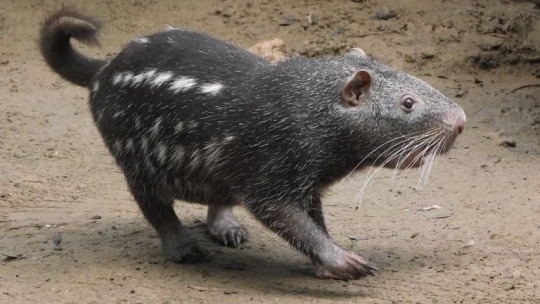


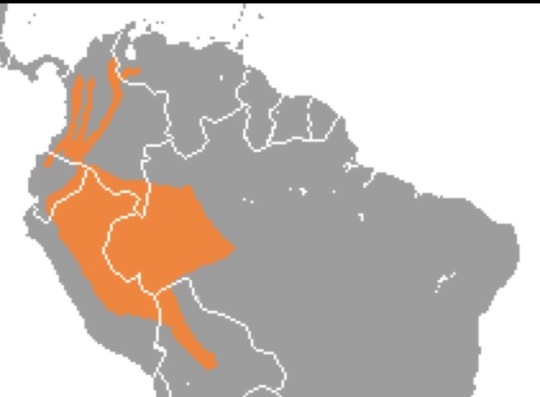
Pacarana
Dinomys branickii
Family Dinomyidae, pavorder Caviomorpha, suborder Hystricomorpha, order Rodentia
This animal is called the pacarana because it looks a bit like a paca, another South American rodent.
They are the only living member of their taxonomic family. Some other members of this family grew to incredible sizes, like the bison sized Josephoartigasia, which is the largest known rodent. Pacaranas themselves are pretty large, weighing as much as 15 kg, or 33lbs.
Pacaranas are very slow moving and peaceful animals. They eat fruits, leaves, and stems of plants and eat sitting down while holding their food like they have hands. It’s very cute.
The males also stand on their hind legs when approaching females during courtship and there was a viral video of one of these guys standing on their hind legs a while back trying to remove soap from their fur. It has been confirmed by an expert that no, you should not put soap on a pacarana.
They’re mainly nocturnal and terrestrial, but they do a bit of climbing.
These animals are vulnerable to becoming endangered.
@jackalspine @fifiibibii
66 notes
·
View notes
Text
I think about how cute monkeys are and forget I have pet rats which are basically monkey adjacent.
6 notes
·
View notes
Text

White-tailed antelope squirrel (Ammospermophilus leucurus)
Photo by Robyn Waayers
#white tailed antelope squirrel#antelope squirrel#ammospermophilus leucurus#ammospermophilus#marmotini#xerinae#sciuridae#sciuromorpha#rodentia#euarchontoglires#placentalia#mammalia#tetrapoda#vertebrata#chordata
38 notes
·
View notes
Text

I think most people are aware of the fact that humans are related to other primates such as chimps, gorillas, mandrills and probably even Curious George. As a matter of fact, humans ARE primates, which means we share a common ancestor with all other primates. The order Primate includes many species other than just humans and animals that we usually call "monkeys", it also includes lemurs and some other minor families.
However, what I was curious to know was what animals are the most closely related to humans after the primates. To find out, we need to go up the ranks in our phylogenetic tree. As seen on the image on top, primates are part of the mirorder (like an order, but bigger) Primatomorpha, which includes the order Dermoptera (yes, Greek nerds, this means something along the lines of "wing skin"). The order Dermoptera consists entirely of colugos, which are also known as flying lemurs. Despite their name, they are not lemurs and despite their appearance, they are not flying squirrels. They just happen to also be equipped with a patagium (the skin membrane they use to glide) due to convergent evolution. While this is surely interesting, colugos are quite obscure animals and I was looking for a group of animals that would be more "commonly known", even if a bit less related to humans.
We can go even higher up in our phylogenetic tree and see that Primatomorpha are part of the grandorder (like a mirorder, but even bigger) Euarchonta and have a sister order, Scandentia. Animals in the order Scandentia are referred to as "tree shrews", but again, the name is misleading because while they are indeed arboreal, they are not shrews. The image above has one example of these creatures, a tupaia, and while they are cute and all, they are still not what I would call a "commonly known animal". Also, note that the position of the order Scandentia in the evolutionary tree is actually debatable as some researchers place them as a sister clade* to the Glires.
Going one more rank up in our phylogenetic tree, we see that Euarchonta are part of the superorder (like a grandorder, but bigger, you get the idea) Euarchontoglires, which includes the clade Glires. Within this clade are found the orders Lagomorpha and Rodentia, which are both comprised of very well known animals, such as rabbits and rats. I think it's pretty cool to think that those animals are quite closely related to primates, and therefore, to humans. Probably this is why they are (sadly) used for animal testing of medicine and cosmetics, although they are also probably used because of economical reasons.
* I will one day make a post about this word, it's actually pretty interesting.
#animals#primates#humans#colugo#order#clade#dermoptera#primatomorpha#scandentia#euarchonta#euarchontoglires#glires#phylogenetic tree#phylogeny
8 notes
·
View notes
Text
found a decapitated wild rabbit in a neighbor’s yard, pics under the cut

#chordata#sarcopterygii#tetrapoda#amniota#synapsida#mammalia#theria#eutheria#boreoeutheria#euarchontoglires#glires#lagomorpha#leporidae#ok that’s enough clades#won’t bother with all those in the future just having fun with them#oh also#animal death#that guy is super dead
0 notes
Text
me and the boys knowing what Euarchontoglires are
#jesse. scandentia's position in the euarchontoglires is still controversial.#iicraft505#learning about this group altered my brain chemistry or whatever it is the kids are saying these days
0 notes
Text
i think nearly everything about human behavior can be explained by our evolutionary background. if we observe the entire tree of mammal phylogenetics we can see that the glires clade (rodents and lagomorphs) and euarchonta (primates, colugos and treeshrews) are grouped into one superorder called euarchontoglires, meaning humans are also technically tree dwelling mice as far as semantics are concerned. anyways there are a lot of morphological similarities one can observe between rodents and primates, namely hands, and using those hands to hold onto something like a sunflower seed or a sandwich and nibble on it while sitting in a comfortable spot. like primates the ears, hands and feet of rodents are also relatively hairless, and they are also hypersocial and studies on rats have suggested they feel empathy and will act upon it. in fact a lot of rat behavior resembles human behavior to the point that many behavioral studies are done on them in order to understand the effects/causes of addiction and isolation etc. of course all these traits developed independently but one could argue that A) the basal form that euarchontoglires originated from was already predisposed to these traits or B) already had some or all these traits in varying quantities and other groups like lagomorphs actually lost them. so the homo genus finally developing visual art as one of the culminations of animal creativity/dexterity and immediately using that skill to animate little rodent people wearing clothes and living in societies parallel to our own over and over and over and over until we are sick of seeing them and wondering wtf is going on just makes perfect sense evolutionarily speaking. it was meant to be
200 notes
·
View notes
Text
So the Preliminary SVP Schedule got released
For those unfamiliar, SVP = Society of Vertebrate Paleontology
usually when paleontologists say "SVP" they mean specifically the conference that SVP hosts each year, one of the biggest events for the "spends their lives studying old bones" people each year
each day has six sessions - three in the morning, three in the afternoon - and they're packed with talks. like, if you want to see talks in two different concurrent sessions, you gotta run around like a maniac
anyways
Wednesday Morning has Sauropods & Ornithischians, Early Mammals & Carnivorans, and then Fishes & Amphibians as three different sessions (all of these are groups of three going forward)
Wednesday afternoon has Dinosaur Soft Tissues, Ungulates, and Marine Reptiles
Thursday Morning has Romer Prize (fancy student talks), Birds, and Preparators' Session
Thursday afternoon has Theropod Flight Origins, Mammal Paleoecology, and Sauropsids
Friday morning has Euarchontoglires & Xenarthra, Archosaurs, and Methods & Paleohistology
Friday afternoon has Actinopterygians, Crocodylomorphs & Turtles, and Paleoecology & Paleoclimatology
Saturday morning has Theropods I, Afrotheria & Mammal Macroevolution, and Synapsids
and Saturday afternoon has Theropods II, Marine Mammals & Bats, and Squamates
The fact that Theropods get four separate focused sessions while Ornithischians and Sauropods are smushed into one is... well, I'm laughing my head off at Theropod bias right now
would you like theropods? Or more theropods? How about some THEROPODS
77 notes
·
View notes
Text
list 5 topics you could talk about for an hour without preparing any material
tag by @azertykeys it's a party !
preface: i'll be honest i cannot talk for an hour. after about 20 minutes i get sweaty and shaky and exhausted and need like a nap. but anyway
bbc merlin lmao ???
mammals :) the family tree of mammals (i'm a bit rusty on euarchontoglires and marsupials but i can do me best)
various movie things in list form. guillermo del toro filmography, horror movies i like and why they're Different from other movies, star wars movies and lore lmao
the history of the english language and french influences from during and after the norman invasion of 1066.....
idk. the power and influence of fanart in fandom spaces as culture creation and as an expression of self-identity within a community. i just wrote a 12-page paper on this
tagging no one. take this information idk. i'm not good at speaking my mind is literally just pictures with maybe a song playing
17 notes
·
View notes
Text
been realizing some things by playing metazooa. for starters, apparently us primates split off with the rabbit/rodent group into our own branch? i didnt know rabbits are closer cousins to us than our dogs and cats. is this why squirrels and hamsters have such good paws for grabbing objects and climbing?
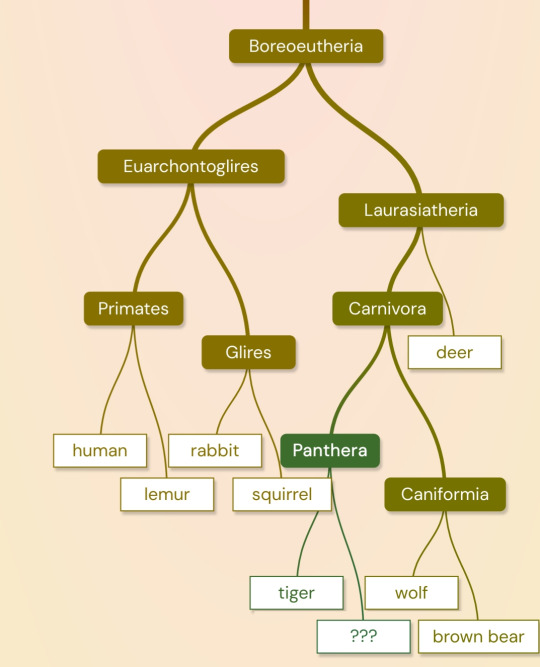
[Image Description: A flowchart of the taxonomy of several animals. Larger groups split off into branches of smaller groups, and will be listed as Group: Branches.
Boreoeutheria: Euarchontoglires and Laurasiatheria.
Euarchontoglires: Primates and Glires.
Primates: Human and Lemur.
Glires: Rabbit and Squirrel.
Laurasiatheria: Carnivora and Deer.
Carnivora: Panthera and Caniformia.
Panthera: Tiger and ???.
Caniformia: Wolf and Brown Bear.
End Image description.]
11 notes
·
View notes
Text
50 metazooa win (53 games)
one of the funnier trees/series of guesses
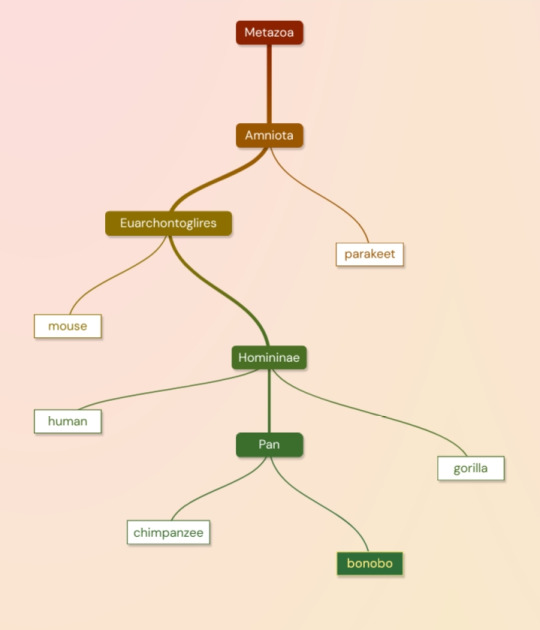
[ID: The metazooa, a cladistics puzzle tree, guessed in 6. Starting with parakett under amniota, then mouse under euarchontoglires. Under homininae is human then gorilla. And finally under pan is chimpanzee then the answer, bonobo. END]
like. they did some monty hall shit to me
Pan (genus)
The genus Pan consists of two extant species: the chimpanzee and the bonobo. Taxonomically, these two ape species are collectively termed panins.
good on me for specificity? completionism?
8 notes
·
View notes
Text
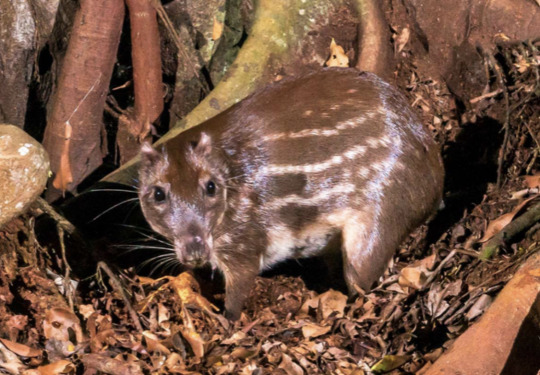



Lowland paca
Cuniculus paca
Family Cuniculidae, pavorder Caviomorpha, suborder Hystricomorpha, order Rodentia
Also known as the spotted paca, tepezcuintle, guardatinaja, pisquinte, jaleb, conejo pintado, guanta, majás, picuro, jochi pintado, boruga, tinajo, guartinaja, gibnut, labba, lapa, and lappe.
There is another animal with a similar name, the Pacarana. But these are not the same animal. They simply have similar appearances.
They are mainly quiet and nocturnal. They dig burrows about 2 metres below the surface with usually more than one exit and are great climbers and swimmers.
They will often seek water to escape predation as they can hold their breaths for several minutes.
They are omnivorous and important seed dispersers. They love fruit and will also eat stems, leaves, tubers, roots, nuts, seeds, and herbs.
They will also eat from carcasses to supplement protein. They eat flesh less often than plants though. They lean more towards herbivorous in the wild and omnivorous in captivity, but have been known to eat flesh in the wild.
There is some conflicting information about their social structure with some sources saying they are largely solitary, and others saying that they are monotonous and form small family groups. Caring for young anywhere from 8 weeks to 6 months.
@jackalspine @fifiibibii
16 notes
·
View notes
Text
Okay the clade that groups us and rats together is called Euarchontoglires, which means science needs to stop trying to turn a chicken into a T-rex when we could have the Rat Man™
9 notes
·
View notes
Text

Eastern chimpanzee (Pan troglodytes schweinfurthii)
Photo by Fabrice Stoger
#eastern chimpanzee#chimpanzee#pan troglodytes schweinfurthii#pan troglodytes#pan#hominini#homininae#hominidae#hominoidea#haplorhini#primates#euarchontoglires#placentalia#mammalia#tetrapoda#vertebrata#chordata
23 notes
·
View notes
Text
moles != rodents
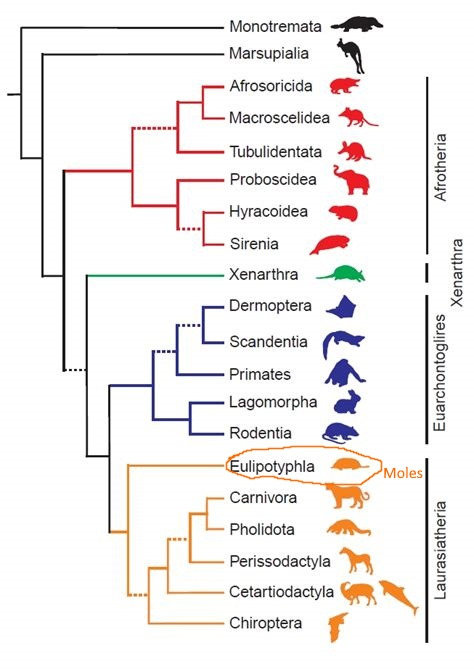
Re: mole classification
This tree isn't totally up to date and indeed these high level relationships remain hard to figure out, but the orange (Laurasiatheria) and blue (Euarchontoglires) groupings are overall correct, and rodents and moles (in the group Eulipotyphia) are not close at all. Rodents are closer to rabbits and primates than to moles, and moles are closer to hoofed mammals and dogs than to rodents.
#taxonomy#phylogeny#clades#Eulipotyphia#mole interest#my posts#Eulipotyphla means 'truly fat and blind'#it includes moles hedgehogs shrews solenodons desmans and moonrats#(and they aren't blind generally)
9 notes
·
View notes
Text

Out of all the animals in Minecraft, rabbit are indeed our closest relatives!
Primates, rodents, rabbits, and a few other small groups all belong to the superorder Euarchontoglires. As there's no rodents or non-humanoid primates in Minecraft, that leaves us and rabbits as each other's closest relatives
57 notes
·
View notes